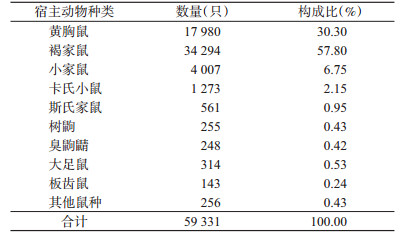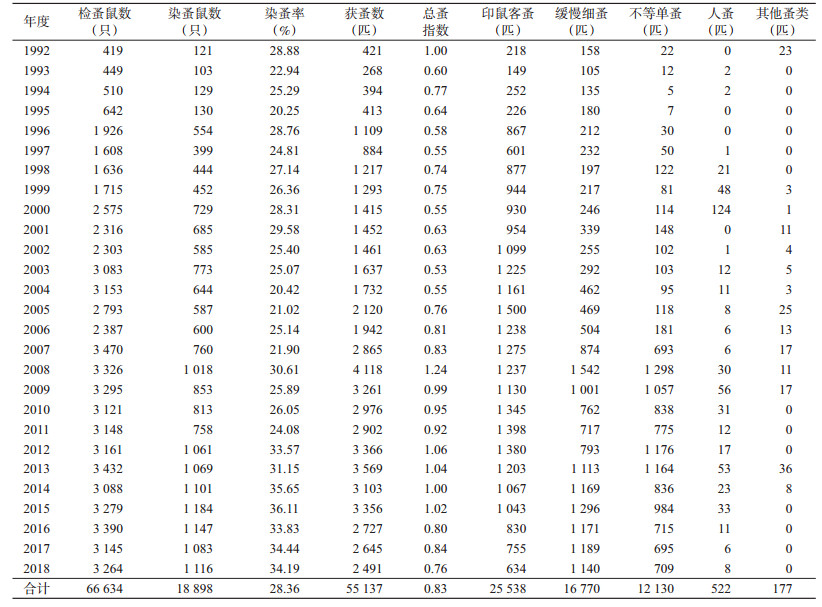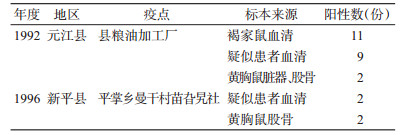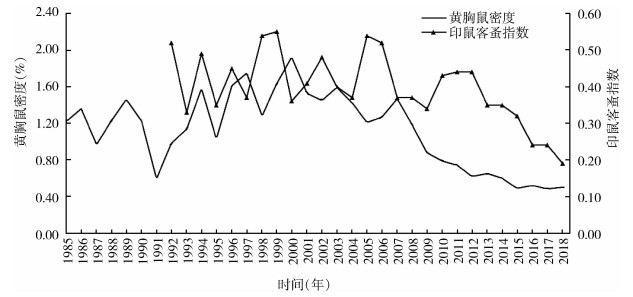扩展功能
文章信息
- 赵秋芳, 左顺武, 杨汝松, 倪兆林, 曾丽萍, 刘红雁, 农璐铭, 吴强
- ZHAO Qiu-fang, ZUO Shun-wu, YANG Ru-song, NI Zhao-lin, ZENG Li-ping, LIU Hong-yan, NONG Lu-ming, WU Qiang
- 云南省玉溪市1985-2018年鼠疫监测结果分析
- An analysis of surveillance results of plague in Yuxi, Yunnan province, China, 1985-2018
- 中国媒介生物学及控制杂志, 2020, 31(3): 340-344
- Chin J Vector Biol & Control, 2020, 31(3): 340-344
- 10.11853/j.issn.1003.8280.2020.03.019
-
文章历史
- 收稿日期: 2020-01-21
玉溪市地处云南省中部, 与昆明、普洱市, 红河哈尼族彝族自治州(红河州)和楚雄彝族自治州(楚雄州)毗邻, 总面积15 285 km2。玉溪市属低纬度高原区, 23°19'~24°53'N, 101°16'~103°09'E, 海拔382~3 137 m, 属亚热带季风气候, 气候立体多样, 生物多样性高, 生态系统复杂多样, 属于滇西山地闽广沿海居民区黄胸鼠(Rattas tanezumi)鼠疫疫源地[1-2]。玉溪市历史上曾发生多次鼠疫疫情, 1992、1996年分别在元江和新平县发生鼠间及人间鼠疫[3]。自1996年以来, 玉溪市未监测到鼠疫疫情, 疫源地处于静息期。鼠疫的发生离不开宿主动物和蚤类, 蚤类是传播鼠疫的主要媒介, 宿主动物又是传播媒介的寄主, 其在鼠疫的传播以及鼠疫耶尔森菌(鼠疫菌, Yersinia pestis)保存方面起到重要作用[1]。研究表明鼠形动物及其蚤类的种群数量、生态习性直接关系动物鼠疫发生、流行的时间和强度[4]。为了解宿主动物及媒介生物种群特征, 有效预防和控制鼠疫的发生和流行, 本文就玉溪市1985-2018年鼠疫监测资料进行了分析。
1 材料与方法 1.1 资料来源1985-2018年玉溪市7县2区按照《全国鼠疫监测方案》和《云南省鼠疫监测方案》要求开展鼠疫监测, 资料来源于鼠疫防治管理信息系统和每月监测报表。
1.2 方法 1.2.1 宿主动物调查采用布笼法, 自然村按月循环进行鼠密度监测, 每户发放3~5个鼠笼, 晚放晨收, 连续放置3 d, 每月布放不少于300个。捕获的鼠类乙醚麻醉后用梳检法采集其体表寄生蚤, 按单个鼠体鉴定、登记蚤种及数量。
1.2.2 实验室检测对采集的蚤类采用拉胃分离培养鼠疫菌, 采取剖检鼠类脏器并取肝脾组织分离培养鼠疫菌。采用间接血凝试验(IHA)和反向间接血凝试验(RIHA)对宿主动物血清、脏器等标本进行血清学检验。

|
采用Excel 2010软件对资料进行整理, R 3.5.1软件统计分析。计算鼠疫宿主动物捕获率、染蚤率、蚤指数等; 黄胸鼠密度与印鼠客蚤(Xenopsylla cheopis)数量均服从正态分布, 采用Pearson相关系数(r)探索两者关系, P < 0.05为相关关系有统计学意义。
2 结果 2.1 病例监测共发生人间鼠疫疫情2起, 确诊病例11例。元江县于1992年在县粮油加工厂暴发人间鼠疫流行, 确诊腺鼠疫患者9例; 新平县于1996年在平掌乡苗旮旯社鼠疫复燃, 发现腺鼠疫病例2例, 主要传染源为黄胸鼠, 传播媒介为印鼠客蚤, 传播途径为鼠→蚤→人, 患者全部治愈。
2.2 宿主动物监测1985-2018年共布放有效笼1 569 638个, 捕获鼠形动物59 331只, 隶属于3目6科13属21种, 总捕获率为3.78%(95%CI:3.75%~3.81%), 年均捕获率在1.78%~5.27%之间波动。其中捕获褐家鼠(R. norvegicus)34 294只, 占捕获总数的57.80%;黄胸鼠17 980只, 占30.30%;小家鼠(Mus musculus)4 007只, 占6.75%;卡氏小鼠(M. caroli)1 273只, 占2.15%;其他鼠种占3.00%。褐家鼠、黄胸鼠为优势鼠种, 小家鼠、卡氏小鼠为常见鼠种, 斯氏家鼠(R. steini)、树鼩(Tupaia belangeri)、臭鼩鼱(Suncus murinus)、大足鼠(R. nitidus)、板齿鼠(Bandicota indica)等其他鼠种为稀有种, 见表 1、2。

|

|
1985-1991年媒介监测数据缺失。1992-2018年共梳检鼠类66 634只, 捕获寄生蚤55 137匹, 隶属于4科5亚科8属8种, 染蚤率为28.36%, 总蚤指数为0.83, 各年染蚤率在20.25%~36.11%之间波动, 蚤指数在0.53~1.24之间波动。其中印鼠客蚤为优势蚤种, 占获蚤总数的46.32%, 缓慢细蚤(Leptopsylla segnis)16 770匹, 占30.41%, 不等单蚤(Monopsyllus anisus)12 130匹, 占22.00%;人蚤(Pulex irritans)522匹, 占0.95%;其他蚤类占0.32%, 见表 3、4。

|

|
共检测宿主动物血清35 412份, 其中1992年元江县鼠血清F1抗体阳性11份, 其余均为阴性; 共检测疑似鼠疫患者血清11份(元江县9份, 新平县2份), 结果均为阳性; 共检测鼠类脏器、股骨、干尸标本7份, 经RIHA鼠疫F1抗原阳性4份(元江和新平县各2份), 见表 5。

|
共检验宿主动物89 968只, 1992年元江县分离到鼠疫菌4株, 其余均为阴性; 检验媒介蚤类33 028匹, 结果均为阴性。
2.6 黄胸鼠密度与印鼠客蚤指数的变化玉溪市1985-2000年黄胸鼠密度呈上升趋势, 2001-2018年呈下降趋势, 主要染疫动物黄胸鼠捕获率为1.12%, 年度间波动较大, 2000年最高(1.92%), 2017年最低(0.48%), 1992、1996年黄胸鼠密度分别为0.98%、1.61%;主要媒介印鼠客蚤指数为0.39, 年度间波动不大, 1999年最高(0.55), 2018年最低(0.19), 1992、1996年印鼠客蚤指数分别为0.52、0.45, 见图 1。1992-2018年, 黄胸鼠密度和印鼠客蚤无显著相关关系(r=-0.09, P=0.658)。

|
| 图 1 1985-2018年云南省玉溪市黄胸鼠密度及印鼠客蚤指数变化 Figure 1 Changes in the density of Rattus tanezumi and index of Xenopsylla cheopis in Yuxi, Yunnan province, China, 1985-2018 |
| |
监测结果显示, 1992、1996年玉溪市各发生1起人间鼠疫疫情, 自1996年至今连续21年未发现动物及人间鼠疫疫情, 表明疫源地处于静息状态。玉溪市主要宿主动物为褐家鼠和黄胸鼠, 其中褐家鼠在数量上具有明显优势, 为优势鼠种。媒介蚤类主要为印鼠客蚤和缓慢细蚤, 二者构成比合计占蚤类总数的76.73%, 其中印鼠客蚤是该鼠疫疫源地的代表性蚤种。以往的研究表明玉溪市鼠疫疫源地是以黄胸鼠为主要宿主, 印鼠客蚤为主要媒介的家鼠型疫源地[5]。本次调查主要媒介情况与全省家鼠鼠疫疫源地调查结果相一致(印鼠客蚤为主要媒介)[6-7], 说明印鼠客蚤作为对人类最具威胁的鼠疫传播媒介, 在云南省家鼠鼠疫疫源地中占绝对优势[8]。主要宿主动物(褐家鼠)与同类型鼠疫疫源地的德宏傣族景颇族自治州[9]和保山市[10]监测结果不一致, 可能与其生活习性、人为因素和生态环境因素有关, 褐家鼠繁殖能力很强, 栖息地非常广泛, 主要栖居于居民区各类建筑物中[11], 特别是牲畜圈棚、仓库、食堂等场所, 随着人类生活条件的改善, 生态环境也随之改变, 而鼠疫监测调查区域也主要集中在居民区及其周围场所, 故出现主要宿主动物与以往研究不相符的情况。另一方面, 黄胸鼠作为家鼠疫源地动物鼠疫主要传染源, 构成比下降说明其造成鼠传疾病暴发和流行的风险在减小[12]。
玉溪市1985-2018年鼠密度总体呈单峰分布, 2010年起各年鼠密度均控制在3%以下。主要染疫动物黄胸鼠捕获率最高为1.92%, 按照《云南省鼠疫控制应急预案》预警指标, 家鼠鼠疫疫源地黄胸鼠密度室内应控制在 < 3%, 室外控制在 < 5%。提示玉溪市鼠密度在较低范围内。1992-2018年总蚤指数为0.83, 主要媒介印鼠客蚤指数为0.39, 总蚤指数和印鼠客蚤指数均维持在相对稳定的水平, 各年印鼠客蚤指数均控制在预警指标(< 1.0)内。1992-2018年, 主要宿主动物黄胸鼠密度和主要媒介印鼠客蚤无显著相关关系, 说明黄胸鼠并不是印鼠客蚤的主要来源, 可能与自然环境的影响有关[13]。血清学和病原学检测结果显示:除1992年元江县和1996年新平县外, 其余年份、县区血清学和病原学检测结果均为阴性。结合鼠密度和蚤指数监测结果, 提示玉溪市鼠疫处于稳定期, 鼠疫疫情发生和流行的风险相对较小。
近10年来, 玉溪市鼠密度和蚤指数相对稳定, 均控制在预警指标以内, 鼠疫疫情发生的风险较小, 但鉴于玉溪市为鼠疫老疫区, 鼠疫主要宿主动物和主要媒介蚤类保持一定数量, 依然存在动物鼠疫发生的可能。因此, 需要坚持开展鼠疫监测工作, 不断提升基层鼠防人员专业技术水平, 提高监测质量; 强化健康教育, 宣传普及鼠疫联防和鼠疫防治基本知识, 进一步规范突发疫情的报告和处理, 提高应对鼠疫突发事件的能力。
| [1] |
秦长育, 许磊, 张荣祖, 等. 中国鼠疫自然疫源地分型研究V.鼠疫宿主生物学特征[J]. 中华流行病学杂志, 2012, 33(7): 692-697. Qin CY, Xu L, Zhang RZ, et al. Ecological-geographic landscapes of natural plague foci in China V. Biological characteristics of major natural reservoirs of Yesinia pestis[J]. Chin J Epidemiol, 2012, 33(7): 692-697. DOI:10.3760/cma.j.issn.0254-6450.2012.07.011 |
| [2] |
许磊, 方喜业, 周冬生, 等. 中国鼠疫自然疫源地的演化动态及环境生态位的生物学特征[J]. 中国媒介生物学及控制杂志, 2015, 26(3): 228-232. Xu L, Fang XY, Zhou DS, et al. The evolutionary dynamics and the ecological niche of natural plague foci in China[J]. Chin J Vector Biol Control, 2015, 26(3): 228-232. DOI:10.11853/j.issn.1003.4692.2015.03.003 |
| [3] |
高跃仙, 赵秋芳, 刘艳瑛, 等. 新平县磨盘山森林湖一起死鼠事件调查结果分析[J]. 应用预防医学, 2019, 25(2): 134-135. Gao YX, Zhao QF, Liu YY, et al. Analysis of the investigation result of a dead rat incident in Mopan Mountain Forest Lake in Xinping county[J]. Appl Prev Med, 2019, 25(2): 134-135. DOI:10.3969/j.issn.1673-758X.2019.02.015 |
| [4] |
孙养信, 吕永杰, 白江春, 等. 陕西省鼠疫疫区媒介蚤季节消长研究[J]. 中国媒介生物学及控制杂志, 2005, 16(6): 442-445. Sun YX, Lyu YJ, Bai JC, et al. Study on the seasonal variation of vector fleas in plague epidemic area, Shaanxi province[J]. Chin J Vector Biol Control, 2005, 16(6): 442-445. DOI:10.3969/j.issn.1003-4692.2005.06.012 |
| [5] |
杨春光, 赵文红, 董兴齐. 云南省家鼠鼠疫流行特征与强度分析[J]. 中国媒介生物学及控制杂志, 2007, 18(3): 226-229. Yang CG, Zhao WH, Dong XQ. An analysis for epidemiological character and intensity of commensal rodent plague in Yunnan[J]. Chin J Vector Biol Control, 2007, 18(3): 226-229. DOI:10.3969/j.issn.1003-4692.2007.03.016 |
| [6] |
苏丽琼, 梁云, 吴鹤松, 等. 云南省1986-2014年人间鼠疫流行病学特征分析[J]. 中国媒介生物学及控制杂志, 2016, 27(4): 386-388, 392. Su LQ, Liang Y, Wu HS, et al. Human plague epidemiological feature analysis in Yunnan province from 1986 to 2014[J]. Chin J Vector Biol Control, 2016, 27(4): 386-388, 392. DOI:10.11853/j.issn.1003.8280.2016.04.019 |
| [7] |
苏丽琼, 苏超, 吴鹤松, 等. 云南省2017年鼠疫监测结果分析[J]. 中国媒介生物学及控制杂志, 2019, 30(4): 404-408. Su LQ, Su C, Wu HS, et al. An analysis of plague surveillance results in Yunnan province, China, in 2017[J]. Chin J Vector Biol Control, 2019, 30(4): 404-408. DOI:10.11853/j.issn.1003.8280.2019.04.011 |
| [8] |
李成胜, 寸待启, 杨雁鸣, 等. 腾冲市2011-2015年鼠疫监测结果分析[J]. 中国媒介生物学及控制杂志, 2016, 27(6): 587-590. Li CH, Cun DQ, Yang YM, et al. Plague surveillance analysis in Tengchong city, 2011-2015[J]. Chin J Vector Biol Control, 2016, 27(6): 587-590. DOI:10.11853/j.issn.1003.8280.2016.06.017 |
| [9] |
赵文红, 郭牧, 段彪, 等. 德宏州1982-2014年鼠疫流行状况分析及防控措施[J]. 医学动物防制, 2016, 32(4): 355-358. Zhao WH, Guo M, Duan B, et al. Epidemic situation analysis and prevention and control measures of plague in Dehong prefecture of Yunnan province from 1982 to 2014[J]. J Med Pest Control, 2016, 32(4): 355-258. DOI:10.7629/yxdwfz201604001 |
| [10] |
李艳萍, 黄东升, 赵明, 等. 云南省保山市2008-2015年鼠疫监测结果分析[J]. 中国媒介生物学及控制杂志, 2018, 29(3): 298-302. Li YP, Huang DS, Zhao M, et al. Surveillance on plague in Baoshan city, Yunnan, China, 2008-2015[J]. Chin J Vector Biol Control, 2018, 29(3): 298-302. DOI:10.11853/j.issn.1003.8280.2018.03.021 |
| [11] |
张家勇, 丁俊, 白玉银, 等. 辽宁省2006-2015年鼠类密度及种群结构分析[J]. 中国媒介生物学及控制杂志, 2017, 28(1): 51-55. Zhang JY, Ding J, Bai YY, et al. Analysis of rodent density and constituent in Liaoning province, China, during 2006-2015[J]. Chin J Vector Biol Control, 2017, 28(1): 51-55. DOI:10.11853/j.issn.1003.8280.2017.01.014 |
| [12] |
赵文红, 郭牧, 苏丽琼, 等. 云南省盈江县鼠疫流行强度与黄胸鼠的消长关系[J]. 医学动物防制, 2018, 34(11): 1055-1059. Zhao WH, Guo M, Su LQ, et al. The relationship of plague epidemic intensity and the succession of Rattus tanezumi in Yingjiang county of Yunnan province[J]. J Med Pest Control, 2018, 34(11): 1055-1059. DOI:10.7629/yxdwfz201811010 |
| [13] |
尹家祥, 董兴齐, 杜春红, 等. 2007年云南省梁河县鼠疫疫源地室内鼠密度和蚤指数调查[J]. 中国地方病学杂志, 2009, 28(4): 417-419. Yin JX, Dong XQ, Du CH, et al. The survey of rat density and flea index in households in villages having previous plague experience in Lianghe county, Yunnan province in 2007[J]. Chin J Endemiol, 2009, 28(4): 417-419. DOI:10.3760/cma.j.issn.1000-4955.2009.04.018 |
 2020, Vol. 31
2020, Vol. 31


